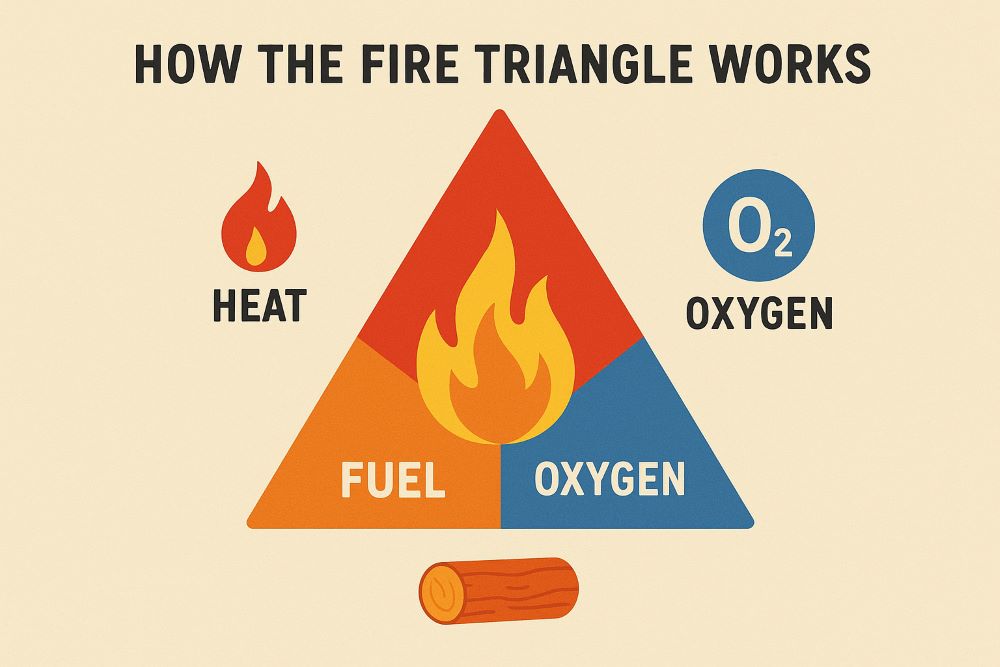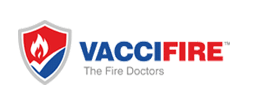How the Fire Triangle Works: Essential Fire Safety Knowledge

Fire is one of the most powerful forces known to humans. It has helped us cook food, stay warm, and build civilizations. But at the same time, fire can be dangerous and destructive if not controlled. To understand how fire behaves and how we can prevent it, we need to learn about the Fire Triangle.
The Fire Triangle is a simple yet powerful model that explains what a fire needs to start and continue burning. By learning this concept, individuals, businesses, and communities can take better steps toward fire prevention and safety.
Fire Triangle Explained
The fire triangle explained is a basic way to understand the science of fire. The triangle has three main sides, each representing a vital element needed for fire:
- Heat – A source of ignition, such as sparks, flames, or hot surfaces.
- Fuel – Any combustible material like wood, paper, cloth, chemicals, or gases.
- Oxygen – Air or other oxidizing agents that allow combustion to take place.
If one side of the triangle is missing, fire cannot exist. This is why firefighters often focus on removing one or more of these elements to extinguish flames.
The 4 Elements for Fire – Beyond the Triangle
In modern fire science, experts sometimes expand the fire triangle into a Fire Tetrahedron. This model includes not just the three elements but also a fourth factor:
- Heat
- Fuel
- Oxygen
- Chemical Chain Reaction
This fourth element explains how fire sustains itself once it starts. The chemical chain reaction is the ongoing process that keeps the fire alive as long as the other three elements are present. By disrupting this chain, specialized extinguishers and fire suppression systems can stop a fire.
Why Fire Needs Oxygen to Burn
One of the most important facts about fire is that fire needs oxygen to burn. Oxygen acts as the “breath” of the fire. In normal conditions, the air we breathe has around 21% oxygen—more than enough to keep flames alive.
This is why fires spread quickly in areas with high ventilation and why limiting oxygen is an effective way to control fire. For example:
- Blanketing with foam or CO₂ removes oxygen from the area.
- Closing doors and windows can slow down fire spread in buildings.
- Fire blankets work by smothering flames, cutting off oxygen supply.
How the Fire Triangle Works in Real Life
The fire triangle isn’t just theory—it applies in real situations:
- Cooking fires: Oil acts as fuel, the stove provides heat, and oxygen in the air keeps it burning.
- Electrical fires: Damaged wires generate heat, nearby materials serve as fuel, and oxygen helps flames spread.
- Forest fires: Dry grass and trees are fuel, sunlight or sparks provide heat, and natural wind supplies oxygen.
By identifying these elements, you can understand how to prevent fires before they begin.
Practical Tips for Fire Safety
Fire safety starts with awareness. Here are some tips for fire safety that everyone should follow:
🔹 Control Heat Sources
- Keep stoves, heaters, and electrical equipment in good condition.
- Do not overload sockets or use faulty wiring.
- Avoid smoking in bed or near flammable materials.
🔹 Manage Fuel
- Store flammable liquids in proper containers.
- Keep paper, cloth, and waste away from open flames.
- Regularly clear dry leaves, trash, or debris from surroundings.
🔹 Limit Oxygen Exposure
- Keep fire doors closed in commercial buildings.
- Use fire extinguishers and fire blankets when needed.
- Seal containers of flammable substances tightly.
🔹 Prepare for Emergencies
- Install smoke detectors and fire alarms.
- Keep fire extinguishers easily accessible.
- Conduct fire drills in workplaces, schools, and housing complexes.
- Educate family members and employees about emergency exits.
The Role of the Fire Triangle in Firefighting
Firefighters are trained to use the fire triangle concept in every situation. Depending on the type of fire, they choose the best strategy:
- Removing Heat: Using water to cool flames.
- Removing Fuel: Creating firebreaks in forests or shutting off gas supply.
- Removing Oxygen: Using foam, sand, or CO₂ to smother flames.
- Stopping Chemical Reaction: Using specialized extinguishers like dry powder.
This systematic approach ensures that fires can be controlled quickly and safely.
Fire Triangle and Workplace Safety
In offices, factories, and warehouses, the fire triangle concept is extremely important. Workplaces often store large amounts of fuel (such as paper, chemicals, or machinery) and use heat-producing equipment. Combined with oxygen, these create a high-risk environment.
Employers must:
- Follow government fire safety regulations.
- Install fire alarms and sprinklers.
- Train employees in fire response.
- Ensure Form B Fire NOC compliance in places like Mumbai and other cities.
Fire Triangle in Daily Life
Even at home, being mindful of the fire triangle can prevent accidents:
- Kitchen safety is crucial since gas stoves combine fuel and heat.
- Candles and incense should never be left unattended.
- Electrical appliances should be switched off when not in use.
Small actions like these make a big difference in reducing fire risks.
The Fire Triangle is more than a theory—it is the foundation of fire safety. By understanding that fire needs heat, fuel, and oxygen, and sometimes a chemical chain reaction, we can take smart steps to prevent and control it.
Whether at home, in the workplace, or outdoors, following simple fire safety tips can protect lives and property. Remember, prevention is always better than cure when it comes to fire hazards.
Stay alert, stay safe, and always respect the power of fire.
Frequently Asked Questions
Q1: What are the three main elements of the fire triangle?
The fire triangle includes heat, fuel, and oxygen. All three are necessary for a fire to start and continue burning.
Q2: What is the fourth element in the fire tetrahedron?
The fourth element is the chemical chain reaction, which explains how fire sustains itself.
Q3: Why does fire need oxygen to burn?
Fire needs oxygen because it supports the combustion process. Without oxygen, flames cannot survive.
Q4: How do firefighters use the fire triangle to stop fires?
They remove one element of the triangle—by cooling (removing heat), smothering (removing oxygen), or taking away fuel.
Q5: What are some tips for fire safety at home?
Install smoke alarms, keep fire extinguishers handy, avoid leaving cooking unattended, and store flammable materials safely.
